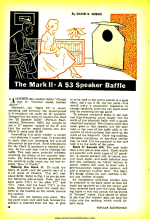So, I was futzing about on the interwebz, looking at single-driver designs, and I ran across the Jordan Triangular Array design. And I thought to myself,
"Self, Our small living room requires speakers to be placed in the corners. Corners are triangles. I have basically no woodworking skills. Hmmm..."
So, what might happen if I cut a triangular base to fit the corner, and put a vertical board that would fill the gap, so that the corner would make the rest of the triangle. Then put a single, (or maybe double) pair of full-range drivers in the upright part. Basically, using the room corners as the other 2/3s of the enclosure. But with a semi-open, kinda-sorta-dipole backside.
And then I thought, "This can't be a new idea, because there are very few new ideas. Somebody must have tried this."
So...
Has anybody tried this?
--Shannon
"Self, Our small living room requires speakers to be placed in the corners. Corners are triangles. I have basically no woodworking skills. Hmmm..."
So, what might happen if I cut a triangular base to fit the corner, and put a vertical board that would fill the gap, so that the corner would make the rest of the triangle. Then put a single, (or maybe double) pair of full-range drivers in the upright part. Basically, using the room corners as the other 2/3s of the enclosure. But with a semi-open, kinda-sorta-dipole backside.
And then I thought, "This can't be a new idea, because there are very few new ideas. Somebody must have tried this."
So...
Has anybody tried this?
--Shannon
In essence it is a great idea, however it's not terribly simple to do properly. You're so close to reflecting surfaces that you need to consider a smooth physical transition. Eg you wouldn't make a waveguide with a throat that didn't fit or was the wrong shape..
Well, not that great... The essence, I mean...
The grade of immersion of the two binary sources is decoded firstly by [the brain] >asking why square brackets? Eh eh ..
to let eco-localization happen and the individual set in space .
Are you ok?
The grade of immersion of the two binary sources is decoded firstly by [the brain] >asking why square brackets? Eh eh ..
to let eco-localization happen and the individual set in space .
Are you ok?
Also "array" and creation of cylindrical waves differs from point source for source recognizability.. well, sorry, firstly there are two sources, or are we in an Atmos-sphere,?!
Yes-this an old idea.
Some examples-
https://www.diyaudio.com/community/...6-david-weems-3-celotex-corner-baffle.380889/
Some examples-
https://www.diyaudio.com/community/...6-david-weems-3-celotex-corner-baffle.380889/
Attachments
As a Briton I have never heard of 'futzing' but it is my new favourite word and I intend to steal it and use it at every opportunity!
Back on topic, and stating facts, not being judgemental in any way:
With the wonders and low cost of digital EQ we can make almost anything sound ok, but unfortunately using two or more full-range drivers will result in heaps of unwanted comb filtering right in the portion of the spectrum where you would want it least!
An array is, by definition, of significant length in relation to the frequencies being reproduced, which a couple of drivers is not.
An enclosure with the top missing is, well, much like a lead guitar combo - no bass!
A 'conventional' triangular sealed or ported speaker would be the best for your application, I believe. There is nothing to stop you building the enclosure - less the top - and experimenting; you might like it, and nothing lost except a little time, a little glue, and another couple of ply triangles!
Back on topic, and stating facts, not being judgemental in any way:
With the wonders and low cost of digital EQ we can make almost anything sound ok, but unfortunately using two or more full-range drivers will result in heaps of unwanted comb filtering right in the portion of the spectrum where you would want it least!
An array is, by definition, of significant length in relation to the frequencies being reproduced, which a couple of drivers is not.
An enclosure with the top missing is, well, much like a lead guitar combo - no bass!
A 'conventional' triangular sealed or ported speaker would be the best for your application, I believe. There is nothing to stop you building the enclosure - less the top - and experimenting; you might like it, and nothing lost except a little time, a little glue, and another couple of ply triangles!
My foot-of-bed, nearly-against-wall OB-U open shallow box uses the "tailgate" at an angle to bounce rear waves toward the ceiling; wings then enclose the space to some height (plus just a bit of EQ). So you can simply extend the (corner) baffles higher and secure some stuffing behind the drivers. A tall trapezoidal baffle can even lean into the corner snugly, forming a quadratically-tapered transmission line....
Last edited:
Thanks for this thread and the related info.
I’m moving into a new house and there are several potential areas to set up systems.
One of them is a formal dining room that we felt we didn’t need and closed off a secondary entrance to the kitchen in.
The other entrance is flanked by two built in custom corner cabinets. The hardwood floor was installed later on around their footprint, so it looks like they will stay.
The cabinets irked me as this is not a large room…11.5 X 13.5 with 8 foot ceilings.
Then I started wondering about the possibility of actually turning the cabinets into some kind of speaker.
I’ve hoarded quite a few different speakers and drivers.
I have some 15” Tannoy I’ve wanted to try in another enclosure for a while. I also have a bunch of front horns and dipole woofers I’ve played with in various arrangements.
I don’t know what would work best as the manner in which the cabinets project into the room would have them cross at only 6 feet along its length.
I’ve used widebands in back loaded horns and crossed them in front of the listening position like this…but I’m not sure how it would work here.
They are nicely built from high quality furniture grade 3/4” cherry plywood. I don’t see any abscesses in the edges of the shelves when I take them out.
The doors are easily removable as are most of the shelves. One shelf is permanent, but I could cut its center out and turn it into a rib brace to allow one large chamber inside the cabinet. A baffle could be easily mounted.
The cabinets are about 28” across the front.
I wondered about how open does open baffle need to be if I wanted to just try mounting a baffle big enough for the 15” Tannoy and two 18” AE Dipole woofers in each cabinet?
It’ll take time before I could even start something like this. We’re still moving and need to sell the old house.
Still, it can’t hurt to gather any information I can on the idea.
I attached some pics for fun. The round horn is a Oris 200. The other is a big B-52 horn I bought on clearance at Parts Express.
I’m moving into a new house and there are several potential areas to set up systems.
One of them is a formal dining room that we felt we didn’t need and closed off a secondary entrance to the kitchen in.
The other entrance is flanked by two built in custom corner cabinets. The hardwood floor was installed later on around their footprint, so it looks like they will stay.
The cabinets irked me as this is not a large room…11.5 X 13.5 with 8 foot ceilings.
Then I started wondering about the possibility of actually turning the cabinets into some kind of speaker.
I’ve hoarded quite a few different speakers and drivers.
I have some 15” Tannoy I’ve wanted to try in another enclosure for a while. I also have a bunch of front horns and dipole woofers I’ve played with in various arrangements.
I don’t know what would work best as the manner in which the cabinets project into the room would have them cross at only 6 feet along its length.
I’ve used widebands in back loaded horns and crossed them in front of the listening position like this…but I’m not sure how it would work here.
They are nicely built from high quality furniture grade 3/4” cherry plywood. I don’t see any abscesses in the edges of the shelves when I take them out.
The doors are easily removable as are most of the shelves. One shelf is permanent, but I could cut its center out and turn it into a rib brace to allow one large chamber inside the cabinet. A baffle could be easily mounted.
The cabinets are about 28” across the front.
I wondered about how open does open baffle need to be if I wanted to just try mounting a baffle big enough for the 15” Tannoy and two 18” AE Dipole woofers in each cabinet?
It’ll take time before I could even start something like this. We’re still moving and need to sell the old house.
Still, it can’t hurt to gather any information I can on the idea.
I attached some pics for fun. The round horn is a Oris 200. The other is a big B-52 horn I bought on clearance at Parts Express.
Attachments
-
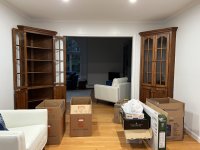 5BA554B6-BCE6-4BE6-9FD3-5840529EBE59.jpeg410.6 KB · Views: 133
5BA554B6-BCE6-4BE6-9FD3-5840529EBE59.jpeg410.6 KB · Views: 133 -
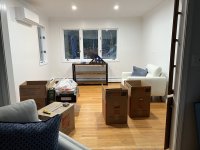 62FC0796-F96D-4FCD-BACF-8C835CEFC7D4.jpeg432.6 KB · Views: 120
62FC0796-F96D-4FCD-BACF-8C835CEFC7D4.jpeg432.6 KB · Views: 120 -
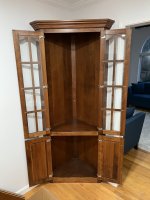 EAA8E8BD-3A80-4152-A105-B95B29A421A6.jpeg429.5 KB · Views: 140
EAA8E8BD-3A80-4152-A105-B95B29A421A6.jpeg429.5 KB · Views: 140 -
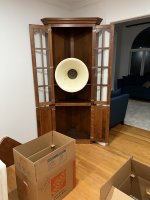 6E9113B0-B089-415C-822D-AE44EDD5C3C8.jpeg409.6 KB · Views: 160
6E9113B0-B089-415C-822D-AE44EDD5C3C8.jpeg409.6 KB · Views: 160 -
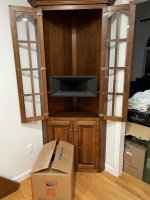 192362DB-6F1A-4B16-BB45-71BD5230203B.jpeg456.8 KB · Views: 140
192362DB-6F1A-4B16-BB45-71BD5230203B.jpeg456.8 KB · Views: 140
Interesting read…thank you.
The reflecting driver orientation made me pause. I’m wondering if a similar design could integrate properly with my existing cabinets.
It so happens I recently picked up a pair of used Lowther PM6A at a very good price. They’ll need new surrounds, but that will be a new DIY adventure.
In the mean time, I have several other 8” wide bands that might be good candidates for a Decca type cabinet.
The reflecting driver orientation made me pause. I’m wondering if a similar design could integrate properly with my existing cabinets.
It so happens I recently picked up a pair of used Lowther PM6A at a very good price. They’ll need new surrounds, but that will be a new DIY adventure.
In the mean time, I have several other 8” wide bands that might be good candidates for a Decca type cabinet.
This idea could work OK with a monopole, but not a dipole type speaker like an open baffle. An OB should be placed away from walls by 1m or more. I don't think you idea quite meets this ROT. The backwave is both close to the front output and constrained in two dimensions by the corner. That doesn't bode well for the in-room response. Also, just because there is some one-pager from a 1950's Popular Electronics mag, doesn't mean this is a "good idea"!
Will it blow up? No.
Will it make sound? Yes.
Will it sound good? No.
Do you care? It depends on what you are trying to achieve here. Throw some fullrangers in a corner with no EQ or crossover and it WILL play some music somehow, but it far, far away from being what would be regarded as a "good" speaker. So you can have some fun and make your project at little risk and if you like it, that is totally fine. But this is not any sort of "good" design approach for a speaker.
Will it blow up? No.
Will it make sound? Yes.
Will it sound good? No.
Do you care? It depends on what you are trying to achieve here. Throw some fullrangers in a corner with no EQ or crossover and it WILL play some music somehow, but it far, far away from being what would be regarded as a "good" speaker. So you can have some fun and make your project at little risk and if you like it, that is totally fine. But this is not any sort of "good" design approach for a speaker.
Hi Charlie
Not to disregard the OPs topic of interest…specifically open baffle in a corner…but I’m interested in any solution that might allow use of my preexisting corner cabinets as a basis for a successful speaker in this room.
I would consider OB if I thought it would work. I had seen this previously:
https://projectgallery.parts-express.com/speaker-projects/corner-dipole-subwoofer/
I thought the idea might have merit.
However, my corner cabinets don’t have large openings on the adjacent walls and I am not sure they could be made to.
My take on the Decca article was that it was a type of Voigt pipe built into a cabinet that used the corner of a room to reinforce the bass output as well as reflecting the high frequencies of the wall to improve dispersion?
I’m no speaker designer or engineer of any kind.
Just looking for ideas…got any?
Not to disregard the OPs topic of interest…specifically open baffle in a corner…but I’m interested in any solution that might allow use of my preexisting corner cabinets as a basis for a successful speaker in this room.
I would consider OB if I thought it would work. I had seen this previously:
https://projectgallery.parts-express.com/speaker-projects/corner-dipole-subwoofer/
I thought the idea might have merit.
However, my corner cabinets don’t have large openings on the adjacent walls and I am not sure they could be made to.
My take on the Decca article was that it was a type of Voigt pipe built into a cabinet that used the corner of a room to reinforce the bass output as well as reflecting the high frequencies of the wall to improve dispersion?
I’m no speaker designer or engineer of any kind.
Just looking for ideas…got any?
The rear horn versions ala Decca are easier to find in the old periodicals (eg Augspurger '51 Nov Audio).
This is sort of half a stubby Bib / backhorn but leaky and well look yourself...semantics fail as footprint increases. Memory failed here for particulars, but this image stashed from the wayback machine ~2k7...posting as perhaps someone else may recall specifics..."ALudwig" and "Silcom" (?) All I remember was that it was reported to work well.
This is sort of half a stubby Bib / backhorn but leaky and well look yourself...semantics fail as footprint increases. Memory failed here for particulars, but this image stashed from the wayback machine ~2k7...posting as perhaps someone else may recall specifics..."ALudwig" and "Silcom" (?) All I remember was that it was reported to work well.
Attachments
Better Bass with Buster page 28
-Furniture speakers
https://www.worldradiohistory.com/Archive-All-Audio/Archive-Audiocraft/Audiocraft-1956-05.pdf
-Furniture speakers
https://www.worldradiohistory.com/Archive-All-Audio/Archive-Audiocraft/Audiocraft-1956-05.pdf
Art Ludwig- WaybackThe rear horn versions ala Decca are easier to find in the old periodicals (eg Augspurger '51 Nov Audio).
This is sort of half a stubby Bib / backhorn but leaky and well look yourself...semantics fail as footprint increases. Memory failed here for particulars, but this image stashed from the wayback machine ~2k7...posting as perhaps someone else may recall specifics..."ALudwig" and "Silcom" (?) All I remember was that it was reported to work well.
https://web.archive.org/web/20100502170425/http://www.silcom.com/~aludwig/
The patent office is filled with them and some were DIY articles in various magazines over the decades at least into the '70s and FWIW, most of my TLs were just a ~full height straight or tapered corner panel.So, what might happen if I cut a triangular base to fit the corner
👍 My first corner speaker, made out of corrugated cardboard.
Paul G. A. H. VoigtThanks for this thread and the related info.
I’m moving into a new house and there are several potential areas to set up systems.
One of them is a formal dining room that we felt we didn’t need and closed off a secondary entrance to the kitchen in.
The other entrance is flanked by two built in custom corner cabinets. The hardwood floor was installed later on around their footprint, so it looks like they will stay.
The cabinets irked me as this is not a large room…11.5 X 13.5 with 8 foot ceilings.
Then I started wondering about the possibility of actually turning the cabinets into some kind of speaker.
I’ve hoarded quite a few different speakers and drivers.
I have some 15” Tannoy I’ve wanted to try in another enclosure for a while. I also have a bunch of front horns and dipole woofers I’ve played with in various arrangements.
I don’t know what would work best as the manner in which the cabinets project into the room would have them cross at only 6 feet along its length.
I’ve used widebands in back loaded horns and crossed them in front of the listening position like this…but I’m not sure how it would work here.
They are nicely built from high quality furniture grade 3/4” cherry plywood. I don’t see any abscesses in the edges of the shelves when I take them out.
The doors are easily removable as are most of the shelves. One shelf is permanent, but I could cut its center out and turn it into a rib brace to allow one large chamber inside the cabinet. A baffle could be easily mounted.
The cabinets are about 28” across the front.
I wondered about how open does open baffle need to be if I wanted to just try mounting a baffle big enough for the 15” Tannoy and two 18” AE Dipole woofers in each cabinet?
It’ll take time before I could even start something like this. We’re still moving and need to sell the old house.
Still, it can’t hurt to gather any information I can on the idea.
I attached some pics for fun. The round horn is a Oris 200. The other is a big B-52 horn I bought on clearance at Parts Express
Lowther TP-1, Brociner Model 4, Voigt
http://www.roger-russell.com/voigt/voigt.htm

voigt corner horn
=====
Decware
https://www.decware.com/newsite/Pro12.htm
====
Pi Speakers
http://www.pispeakers.com/catalog/product_info.php/products_id/121
https://audioroundtable.com/forum/index.php?t=msg&goto=81642&
The easist would be to place speakers in the cabinets.
Open the doors when listening, close when not.
Or remove the glass &/or doors, etc ?
If you don't like the speakers, you can try others.
chair cane
Last edited:
A friend in Montreal built these corner horns with 8" fullrange drivers. They sounded very nice, good low end energy.


- Home
- Loudspeakers
- Full Range
- Dumb idea... corner-loaded open baffle
